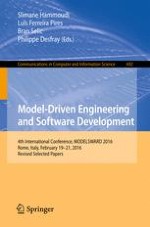
2017 | OriginalPaper | Chapter
Survey on the Applicability of Textual Notations for the Unified Modeling Language
Authors : Stephan Seifermann, Henning Groenda
Published in: Model-Driven Engineering and Software Development
Publisher: Springer International Publishing
Activate our intelligent search to find suitable subject content or patents.
Select sections of text to find matching patents with Artificial Intelligence. powered by
Select sections of text to find additional relevant content using AI-assisted search. powered by